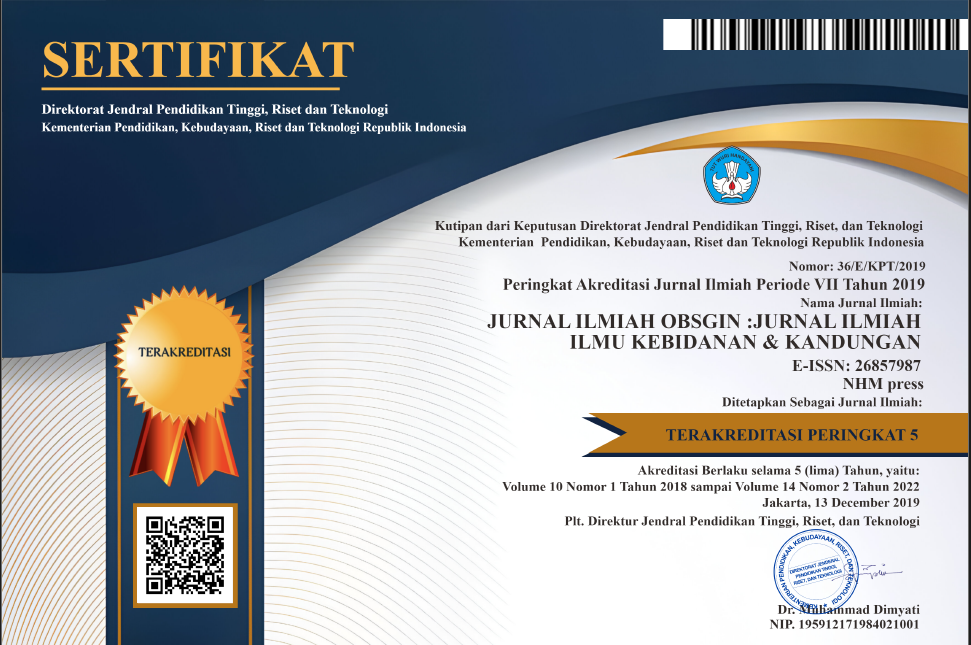HUBUNGAN FAKTOR SOSIO DEMOGRAFI DENGAN PEMILIHAN METODE KONTRASEPSI PADA WANITA USIA SUBUR (WUS)
Abstract
The use of contraception aims to fulfill everyone's reproductive rights, by helping to plan when and how many children they want and prevent unwanted pregnancies. The proper use of contraceptives can also reduce the risk of maternal and infant mortality. This study aims to determine the relationship between socio-demographic factors and contraceptive selection. The design of this study is quantitative with a cross sectional study approach. The sample in this study was all women of childbearing age who were sexually active, sampling using the purposive sampling technique totaled 99 people. Data were obtained by interviews using questionnaires. The results showed that there was a significant relationship between age (p=0.022) and education level (p=0.015) and there was no relationship between occupation (p=0.167) and long-term contraceptive selection. Health service institutions must further improve the quality of counseling and long-term contraceptive services, so that they can attract the interest of the public in particular
References
Astin, Hanfah Nur. (2020). Konsep Pelayanan Kontrasepsi Dan KB, CV Media Sains Indonesia, Bandung.
Bahriah, Y. d. (2023). Pelayanan Kontrasepsi Jangka Panjang (MKJP) di Wilayah Kerja PMB Lismarini Tahun 2023. Community Development Journal , 8385.
Dewi Cahyani, N. L. (2021). Karakteristik Akseptor Non Metode Kontrasepsi Jangka Panjang Pada Wanita Usia Subur. Jurnal Ilmiah Kebidanan .
Di S, Jawa P, Dan T, Kalimantan P, Penelitian P, Keahlian B, et al. Dalam Penyelenggaraan Kesehatan Reproduksi The Role of Local Government in the Implementation of Reproductive Health 2018;1–16.
Fatoni Z, Astuti Y, Seftiani S, Situmorang A, Widayatun NFN, Purwaningsih SS. Implementasi kebijakan kesehatan reproduksi di Indonesia: sebelum dan sesudah reformasi. Jurnal Kependudukan Indonesia (JKI). 2015;10(1):65.
Herowati D, Sugiharto M. Hubungan antara kemampuan reproduksi, kepemilikan anak, tempat tinggal, pendidikan dan status bekerja pada wanita sudah menikah dengan pemakaian kontrasepsi hormonal di Indonesia tahun 2017. Bul Penelit Sist Kesehat. 2019;22(2):91–8.
WHO,world contraceptive day, [Internet] 2017 avaliabel from
https://www.who.int/reproductivehealth/topics/family_planning/world-contraception-day-2017/en/
Ikhtiyaruddin. (2021) Metode Kontrasepsi Jangka Panjang, CV. Global Aksara Pers, Surabaya.
Jasa, N. E., Listiana, A., & Risneni. (2021). Paritas, Pekerjaan dan Pendidikan Berhubungan dengan Pemilihan Alat Kontrasepsi MKJP pada Akseptor KB. Jurnal Kebidanan Malahayati , 748.
Kementerian Kesehatan Republik Indonesia. Profil kesehatan Indonesia 2017. Jakarta; 2018.
Kementerian Kesehatan Republik Indonesia. Profil kesehatan Indonesia 2020. Jakarta; 2021.
Liwang F, Bhargah A, Kusuma IBH, Prathi-windya GG, Indaya IG, Putra S, et al. Gambaran penggunaan kontrasepsi hormonal dan non hormonal di wilayah kerja UPT Puskesmas Tampak Siring 1. Intisari Sains Medis. 2018;9(3):41-6.
Mullati, Erna. (2021). Pedoman Pelayanan Kontrasepsi Dan Keluarga Berencana (Kementrian Kesehatan), Jakarta.
Rochadi, K., Sembiring, R., & Nababan, D. (2022). Analisis Faktor-Faktor Yang Mempengaruhi Partisipasi Pus Dalam Metode Kontrasepsi Jangka Panjang (MKJP) Di Kecamatan. 6 (April), 113–124.
Setyorini, C., Lieskusumastuti, A. D., & Lilik, H. (2022). Faktor-faktor yang mempengaruhi Penggunaan Metode Kontrasepsi Jangka Panjang (MKJP): Scooping Review. Journal of Health Research











